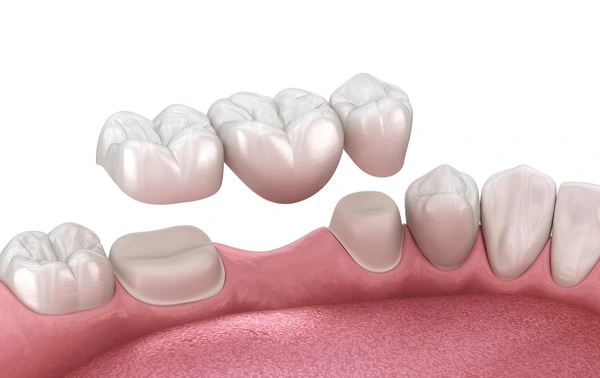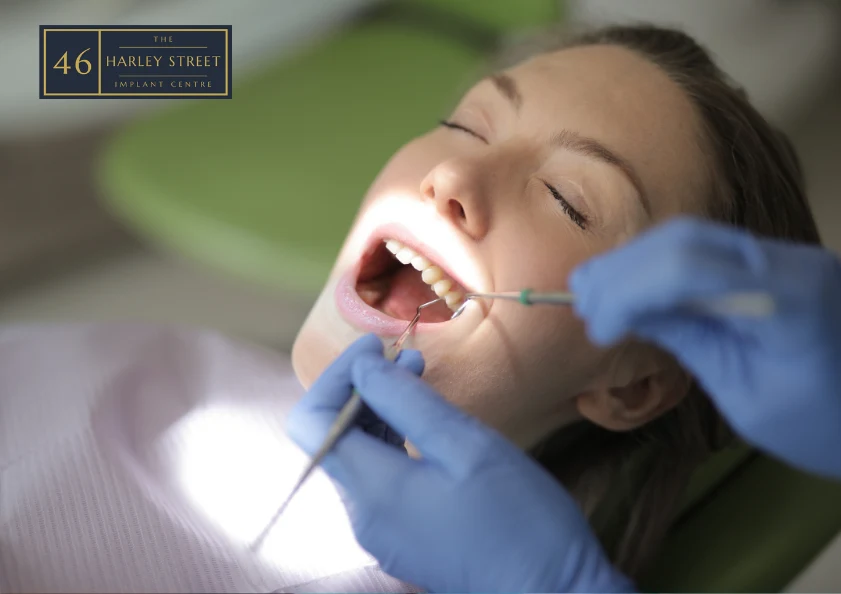Wisdom Tooth Removal Cost UK. A Complete Guide Wisdom teeth are the last molars to appear in the mouth, usually developing between …
What Is a Dental Bridge? Discover the Process, Benefits, and Drawbacks
Dentists will often encounter patients who are curious about dental bridges. Whether you’re missing a single tooth or several teeth, the idea of restoring your smile with a dental bridge can seem both exciting and a little overwhelming. This blog aims to demystify dental bridges, exploring what they are, the materials used, when they are recommended, alternative options, their longevity, potential risks, and the future of dental bridges.

What is a dental bridge?
A dental bridge is a common intervention for tooth loss. It is a fixed dental restoration (prosthesis) used to replace one or more missing teeth that may be causing both functional or cosmetic problems. As it says in its name, a dental bridge literally bridges the gap between teeth, extending across the area where teeth may be missing.
A bridge consists of one or more artificial teeth (pontics) that are anchored to either natural teeth or dental implants. The teeth the bridge anchors to are known as abutments and are often reshaped using ‘’crowns’’ to help hold the bridge securely in place. The result is a natural-looking and fully functional set of teeth that restores both your smile and your ability to chew and speak properly.
Types of dental bridge
There are several types of dental bridges available, depending on the specific needs and conditions of the patient:
Traditional Bridges: this is the most common type of bridge that is used when there is one affected tooth. It involves creating a crown for the tooth or implant on either side of the missing tooth, with an artificial tooth placed in-between. This is mostly used when there are natural teeth preserved on either side of the gap. These bridges can last a long time, with some studies showing over 80% 10 year survival rate. Due to extensive preparation needed to fit crowns onto the adjacent teeth, the major disadvantage of this method is the risk of tooth reduction to the abutments.
Cantilever bridge: this is similar to a traditional bridge but the artificial tooth is only secured to teeth on one side of the gap. This was introduced to limit damage to healthy adjacent teeth caused by the extensive preparation required.
Resin bonded bridges (RBB): this involves anchoring the artificial tooth using metal or porcelain ‘wings’ bonded to the back of adjacent teeth. This method allows fixed replacement of missing teeth in a more conservative way by reducing the required preparation of the adjacent teeth which can lead to endodontic complications such as fractures.
Implant supported bridges: These are ideal when more than one tooth is missing. Instead of being supported by crowns on natural teeth, this type of bridge is supported by dental implants, offering a very stable and durable solution and limiting damage to existing teeth. It is however a longer process, often involving various visits to the dentist to place the implants, prosthetic teeth and finally the bridge. This is best used when 3 teeth are missing in a row.
When are dental bridges used?
Dental bridges are typically recommended when one or more teeth are missing and there are healthy teeth or implants on either side of the gap to support the bridge. They are used when there is either a functional or cosmetic need. For example, they are often used to:
Restore Your Smile:A dental bridge helps regain your full smile to help restore confidence.
Improve Chewing: Missing teeth can make it difficult to chew food properly, potentially leading to digestive issues. This is particularly important in older adults.
Restore Speech: our teeth play a vital role in speech. Missing teeth can affect our pattern or speech and lead to trouble pronouncing words and dribbling.
Maintain Facial Shape: interestingly, our teeth have a really important role in shaping our face. Missing teeth can lead to facial sagging that can contribute to looking older. Restoring these teeth via a bridge may help restore some of your youth!
Prevent Teeth From Shifting: When a tooth is lost, the surrounding teeth may start to move towards this gap, leading to misalignment and crowding. This can have a number of dental complications including fractures, tooth decay, jaw pain and cosmetic concerns.
What materials are used for dental bridges?
There are a variety of different materials used for dental bridges depending on the type of bridge and the compatibility with the patient’s natural teeth. The most common materials used include:
Porcelain or ceramic: porcelain or ceramic bridges look incredibly natural and can be colour-matched to your teeth. This is a good choice for areas that are highly visible in the mouth. Porcelain is often coupled with metal to increase the strength and longevity of the bridge.
Zirconia: zirconia is a biocompatible and highly durable material used most commonly in implant supported bridges.
Metal Alloys: Gold and other metal alloys are highly durable, resistant to corrosion and have acceptable biocompatibility. Metal alloys are typically reserved for the molars or teeth that are not visible.
Composite Resin: This is the material used for RBB described above. While not as strong as other materials, it’s a more conservative option and requires less tooth preparation.
How can we help at The Harley Street Implant Centre?
Dr James is experienced at placing bridges as either part implant supported bridges or completely independently from dental implants. If you would like to find out more about how we can replace missing teeth and enhance your smile, please reach out via our contact form below, or book in for a new FREE consultation with Dr Anthony James.
IV Sedation Myths : 3 Of The Most Common Myths Debunked
For many patients, the most difficult part of getting dental implants is not the surgery itself but making the decision to seek …
Non Surgical Wisdom Tooth Extraction Recovery
Non Surgical Wisdom Tooth Extraction Recovery: A Harley Street Guide Recovering from a non-surgical wisdom tooth extraction is usually straightforward, but knowing …
Why We Built a High-End Dental Implant Clinic from Day One, And Why It Matters for Your Care
When people hear that we built a high end dental implant clinic on Harley Street, the first question they often ask is …



